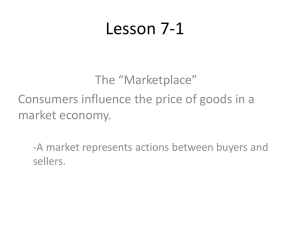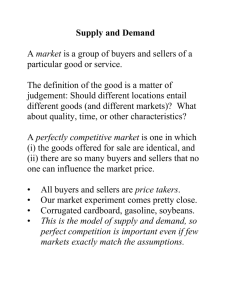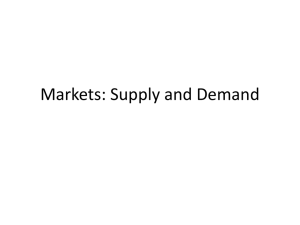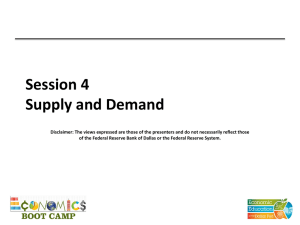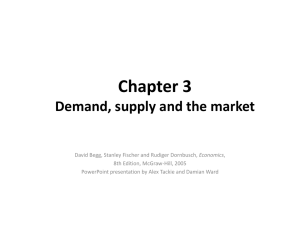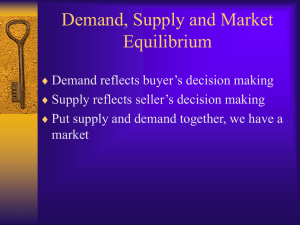CHAPTER 4 - FIU Faculty Websites
advertisement
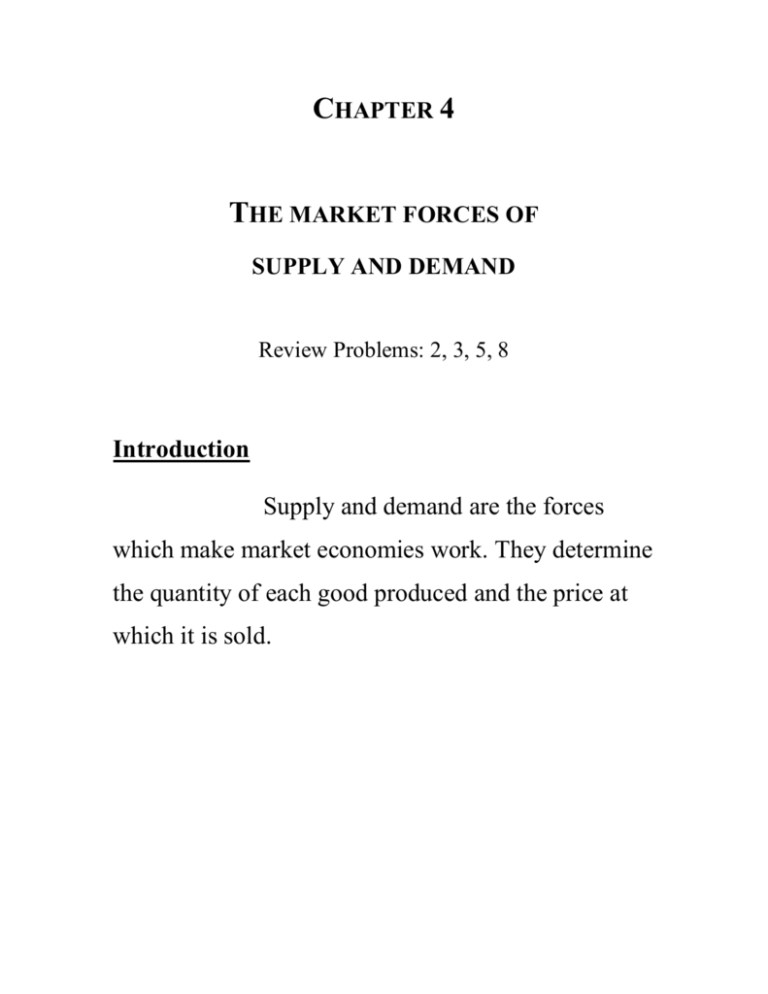
CHAPTER 4 THE MARKET FORCES OF SUPPLY AND DEMAND Review Problems: 2, 3, 5, 8 Introduction Supply and demand are the forces which make market economies work. They determine the quantity of each good produced and the price at which it is sold. 4-1 Markets and Competition Definition of supply and demand - refers to the behavior of people as they interact with one another in markets. Definition of a market - a group of buyers and sellers of a particular good or service Examples: Highly organized markets like agricultural commodities markets where buyers and sellers meet at appointed times in specific places. Less organized markets like the market for ice cream; not all consumers buy at the same time, in the same location and there are many sellers who may post different prices Definition of competitive market - a market in which there are many buyers and many sellers so that each one has a negligible impact on the market price; In this chapter, markets are assumed to be competitive. Perfectly competitive markets are characterized by 1.goods offered for sale being the same (homogeneous) and 2.so many buyers and sellers that no one single buyer or seller can influence the market price Examples of markets which are NOT perfectly competitive: Definition of monopoly - a market with one seller who sets the price; local cable TV company Definition of oligopoly - a market with a few sellers where sellers do not compete aggressively; some airline routes Definition of monopolistic competition - a market with many different sellers offering slightly different products; the software industry offering word processing programs 4-2 Demand Definition of demand - the amount of a good that buyers are willing and able to purchase (at various prices) Determinants of Demand: 1. Price - If prices rise, you buy less ice cream; if prices fall, you buy more ice cream. Therefore quantity demanded is negatively (inversely) related to price. Law of demand - Other things equal, when the price of a good rises, the quantity demanded of the good falls. Definition of ceteris paribus - Latin for "other things being equal." It signifies that all relevant variables are being held constant except those being studied at the moment 2. Income - When income falls, you probably buy less of most goods since you have less money to spend overall. Definition of normal good - a good you buy less of when your income falls; most goods are normal goods Definition of inferior good - a good you buy more of when your income falls; bus rides (instead of cars or taxi rides), hot dogs (instead of higher priced meats) 3. Prices of Related Goods - Sometimes prices of others goods can affect the price of the good in question Definition of substitutes - goods used in place of one another. When a decrease in the price of one good reduces the demand for another good, the goods are called substitutes; hot dogs and hamburgers, sweaters and sweatshirts Definition of complements - Goods used together. When a decrease in the price of one good raises the demand for another good, the goods are called complements; ice cream and fudge, computers and software, camera and film 4. Tastes - your preference for one particular product or another. If you like something, you buy more of it. Economists consider changes in tastes but generally don't try to explain why people have the tastes they have. 5. Expectations - Your demand for a good or service today may depend on your expectations about the future. If you expect more income next month, you may buy more ice cream today. If you expect ice cream to go on sale next week, you may buy less this week. 6. Number of buyers - The more buyers there are in the market the higher the demand Demand Schedules and Curves: Definition of demand schedule - a table that shows the relationship between the price of a good and the quantity demanded Definition of demand curve - a downward-sloping graph relating price and quantity demanded Definition of market demand - the sum of individual demands for a particular good or service. It shows how the total quantity demanded of a good varies as the price of the good varies. See Table 4-2. Shifts in the Demand Curve: Changes in any of the determinants, other than the price of the good itself, shift the demand curve. Case Study: Two Ways to Reduce the Quantity of Smoking Demanded 1. change tastes and preferences by informing people of the danger of smoking and/or prohibiting cigarette advertising 2. raise the price by increasing taxes on the manufacture of cigarettes 4-3 Supply Definition of supply - the amounts of a good producers are willing and able to make available for sale at all various prices Definition of quantity supplied - the amount that sellers are willing and able to sell (at a given price) The Determinants of Individual Supply: 1. Price - Suppliers find it more profitable to produce at higher prices than lower prices. Higher prices will tend to be associated with higher quantities supplied. Law of Supply - Other things equal, when the price of a good rises, the quantity supplied of the good also rises. The price and quantity supply are positively related (or demonstrate a direct relationship). When price rises, quantity supplied rises and when price falls, the quantity supplied falls. 2. Input prices - When the prices of one or more of the inputs that are used to make a product rise, producing the good becomes less profitable, and sellers supply less of the good. 3. Technology - By reducing firms' costs, advances in technology raise supply. 4. Expectations - The quantity of a good a seller supplies today may depend on her expectations of the future. 5. Number of sellers - the more sellers, the more of a good will be made available for sale. The Supply Schedule and the Supply Curve: Definition of supply schedule - a table that shows the relationship between the price of a good and the quantity supplied Definition of supply curve - a graph of the relationship between the price of a good and the quantity supplied; since supply curves show a positive relationship between price and quantity supplied, they are upward-sloping Market Supply versus Individual Supply: Definition of market supply - the sum of all the supplies of all sellers in the market; See Table 4-5 Shifts in the Supply Curve: Changes in any of the determinants of supply will shift the supply curve, except when the price of the good itself changes. When the price of the good changes, it is represented on the graph as a movement from one point on the supply curve to another point on the same supply curve. A change in supply is a shift of the supply curve while a movement along the curve is just a change in quantity supplied. 4-4 Supply and Demand Together Definition of equilibrium - the place at which the supply and demand curves cross - where supply and demand have been brought into balance and the quantity demanded is equal to the quantity supplied Definition of equilibrium price - the price that balances supply and demand, sometimes called the market-clearing price. At this price, the quantity of the good that buyers are willing and able to buy exactly balances the quantity that sellers are willing and able to sell Definition of equilibrium quantity - the quantity supplied and the quantity demanded when the price has adjusted to balance supply and demand Definition of excess supply - a situation in which quantity supplied is greater than quantity demandedprice is above equilibrium and tends to fall to achieve balance in the market Definition of excess demand - a situation in which quantity demanded is greater than quantity suppliedprice is below equilibrium and tends to rise to achieve balance in the market Law of supply and demand - the claim that the price of any good adjusts to bring the supply and demand for that good into balance Definition of comparative statics - comparing an old equilibrium and a new equilibrium; for us, this will be after there has been a change in supply or demand or both. Three Steps to Analyzing Changes in Equilibrium: 1.Decide whether the event shifts the supply or demand curve (or perhaps both). 2.Decide which direction the curve shifts. 3.Use the supply-and-demand diagram to see how the shift changes the equilibrium. Change in demand example: Hot weather changes the demand curve for ice cream by changing people's tastes. The demand curve shifts to the right and both equilibrium price and quantity rise. Change in supply example: There is a summer earthquake which destroys several ice cream factories. The number of sellers is reduced and the supply curve shifts to the left. Equilibrium price will rise, while equilibrium quantity will fall. Consumers have not changed how they feel about ice cream fundamentally; they buy less as a reaction to the higher price, consistent with the law of demand. Changes in both demand and supply example: Suppose the hot weather and the earthquake occur at the same time. Both curves shift as they did before. 4-5 Conclusion: How Prices Allocate Resources The prices determined by the interaction between suppliers and demanders serve as signals that guide the allocation of resources. Because resources are scarce, their prices are usually indications of how much society values them. Prices, in conjunction with people's income, determine who gets what. Prices also help determine who produces each good and how much is produced. Prices serve to coordinate markets - millions of people buying and selling millions of products.

